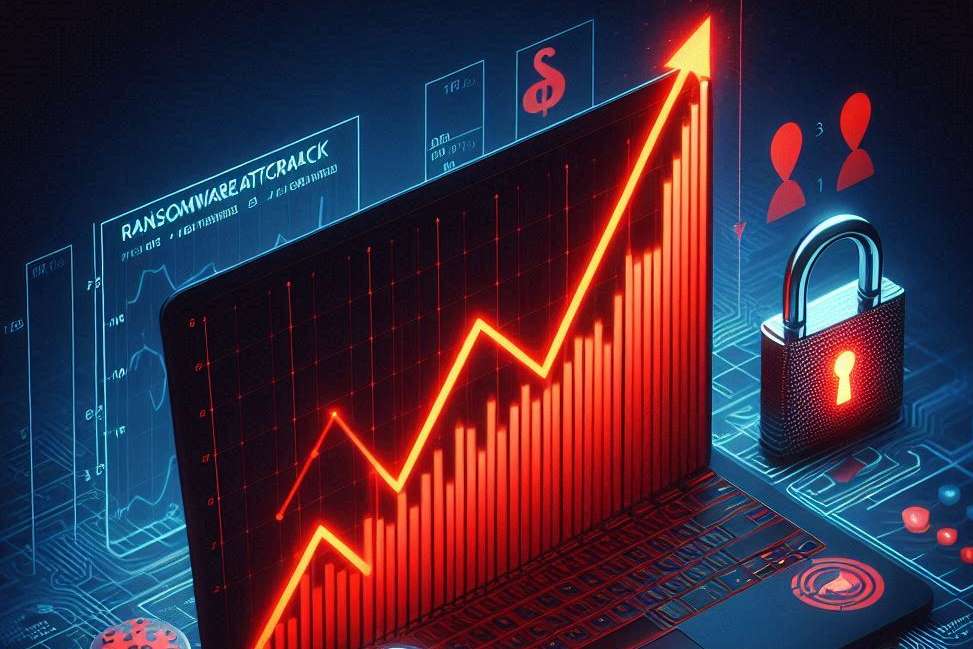In today’s digital world, ransomware attacks are becoming more frequent and severe, posing significant risks to individuals and organizations alike. Cybercriminals are evolving their methods, making it crucial to stay informed and prepared. This blog post will explore the rise in ransomware attacks and offer practical strategies for protecting your data.
Table of Contents
What is Ransomware?
Ransomware is a type of malicious software that locks or encrypts your data, demanding a ransom to restore access. Typically, these attacks come with a time limit, pressuring victims to pay quickly. Payments are often requested in cryptocurrencies, making it harder to trace the culprits.


Different Types of Ransomware
- Crypto Ransomware: Encrypts data and demands a ransom for the decryption key.
- Locker Ransomware: Locks the user out of their device, preventing access to any files or applications.
- Scareware: Shows fake warnings about malware infections and demands money to fix non-existent problems.
- Doxware/Leakware: Threatens to publish sensitive information unless the ransom is paid.
Why Are Ransomware Attacks Increasing?
Several factors are driving the surge in ransomware attacks:


Greater Digital Dependency
As businesses and individuals increasingly rely on digital platforms, the opportunities for cybercriminals to exploit vulnerabilities have multiplied.
More Advanced Attack Methods
Cybercriminals continuously enhance their tactics, employing sophisticated encryption and exploiting new vulnerabilities. These advanced attacks often target critical sectors like infrastructure, healthcare, and finance, where the stakes are incredibly high.
Ransomware-as-a-Service (RaaS)
Ransomware-as-a-Service has lowered the barrier to entry for cybercrime. Even those with minimal technical skills can now launch attacks using tools rented or purchased from the dark web.
Remote Work Weaknesses
The shift to remote work, accelerated by the COVID-19 pandemic, has exposed many vulnerabilities in home networks and remote access systems. Cybercriminals are exploiting these weaknesses to infiltrate corporate networks.
Notable Ransomware Attacks
Several high-profile ransomware attacks have recently made headlines, underscoring the severity of the threat:
Colonial Pipeline
In May 2021, the Colonial Pipeline, a crucial fuel pipeline in the U.S., was hit by a ransomware attack, leading to fuel shortages along the East Coast. The company paid $4.4 million to regain access to its systems.
JBS Foods
JBS Foods, the world’s largest meat processing company, was attacked in June 2021. The incident disrupted meat supplies and forced the company to pay an $11 million ransom.
Kaseya VSA
In July 2021, Kaseya VSA, a remote management software provider, was targeted, affecting hundreds of managed service providers and thousands of businesses worldwide. The attackers demanded $70 million, making it one of the largest ransomware attacks ever.
The Current Landscape
Recent Attacks
- Conti Ransomware:
- Description: Conti is a sophisticated ransomware strain that targets organizations. It exploits vulnerabilities in remote desktop services and spreads laterally within networks.
- Notable Victims: Healthcare institutions, manufacturing companies, and government agencies.
- Ransom Demands: Typically in the millions of dollars.
- DarkSide Ransomware:
- Description: DarkSide gained infamy after the Colonial Pipeline attack. It focuses on critical infrastructure and often exfiltrates sensitive data before encrypting files.
- Notable Victims: Colonial Pipeline, JBS (meat processing company), and others.
- Ransom Payments: DarkSide’s operators use a “double extortion” model, threatening to leak stolen data if the ransom isn’t paid.
- REvil (Sodinokibi):
- Description: REvil is a prolific ransomware-as-a-service (RaaS) operation. Affiliates distribute the malware, and the group takes a cut of the ransom payments.
- Notable Victims: Law firms, financial institutions, and managed service providers (MSPs).
How to Protect Your Data from Ransomware
Given the growing threat, protecting your data from ransomware requires a proactive approach. Here are some effective strategies:
1. Strengthen Cybersecurity
Enhancing your cybersecurity defenses is your first line of protection:
- Firewalls: Use robust firewalls to control incoming and outgoing network traffic.
- Antivirus Software: Regularly update antivirus software to detect and block malicious programs.
- Intrusion Detection Systems (IDS): Monitor network traffic for suspicious activities with IDS.
2. Backup Your Data Regularly
Regular data backups are essential to mitigate the impact of a ransomware attack. Ensure backups are:
- Frequent: Schedule regular backups to keep recent data safe.
- Offline: Store backups offline to prevent them from being encrypted during an attack.
- Tested: Regularly test backups to ensure they can be restored successfully.
3. Educate Employees
Human error often leads to ransomware infections. Conduct regular training sessions to teach employees about:
- Phishing Scams: How to recognize and avoid phishing emails with malicious links or attachments.
- Safe Browsing: Avoiding suspicious websites and not downloading software from untrusted sources.
- Incident Reporting: Reporting any suspicious activities or potential security incidents to IT promptly.
4. Keep Software Updated
Regularly updating software and systems is crucial to closing security gaps. Implement a patch management strategy to:
- Automate Updates: Enable automatic updates for operating systems, applications, and security software.
- Prioritize Critical Patches: Apply patches for critical vulnerabilities as soon as they are available.
- Monitor Announcements: Stay informed about security advisories from software vendors.
5. Segment Your Network
Network segmentation involves dividing your network into smaller, isolated segments, limiting the spread of ransomware:
- Create Subnets: Divide your network into smaller subnets with restricted communication.
- Access Controls: Restrict access to sensitive data based on user roles.
- Use VLANs: Separate different types of network traffic with Virtual Local Area Networks (VLANs).
6. Use Multi-Factor Authentication (MFA)
MFA adds an extra layer of security by requiring multiple verification forms before granting access:
- Authentication Apps: Use apps that generate time-sensitive verification codes.
- MFA Policies: Enforce MFA for accessing critical systems and sensitive data.
- User Education: Train users on the importance and use of MFA.
7. Develop an Incident Response Plan
An incident response plan helps minimize the impact of a ransomware attack. Develop a plan that includes:
- Preparation: Define roles and responsibilities for responding to ransomware incidents.
- Detection and Analysis: Implement tools to detect and analyze attacks.
- Containment and Eradication: Isolate affected systems and remove ransomware.
- Recovery: Restore data from backups and verify system integrity.
- Review: Conduct post-incident reviews to learn and improve future responses.
8. Consider Cyber Insurance
Cyber insurance can provide financial protection against ransomware attacks. When choosing a policy, consider:
- Coverage: Ensure the policy covers ransomware, including ransom payments and recovery costs.
- Policy Limits: Review limits to ensure they cover potential losses.
- Exclusions: Understand any policy exclusions or limitations.
Conclusion
The rise in ransomware attacks is a stark reminder of the evolving digital threat landscape. Cybercriminals are becoming more sophisticated, targeting essential services with devastating consequences. Protecting your data requires a multi-layered approach, including robust cybersecurity measures, regular backups, employee training, and incident response planning.
Stay informed about the latest ransomware trends and adopt proactive security practices to reduce your risk. Remember, preventing an attack is always more cost-effective than recovering from one. Act now to protect your data and ensure the resilience of your digital assets against the growing ransomware threat.
Extra Tips for Enhanced Ransomware Protection
While the strategies above are fundamental, additional measures can further enhance your security posture:
1. Use Advanced Threat Detection
Invest in tools that leverage Artificial Intelligence (AI) and machine learning to identify and respond to threats in real-time. These tools can detect unusual behavior, like rapid file encryption, and take immediate action.
2. Adopt Zero Trust Architecture
Zero Trust means never trusting any user or device by default, even within your network:
- Continuous Verification: Continuously verify user and device identities.
- Least Privilege Access: Grant users only the access they need.
- Micro-Segmentation: Use fine-grained segmentation to isolate sensitive data.
3. Monitor and Audit Network Activity
Regularly monitor and audit network activity to detect suspicious behavior. Implement a Security Information and Event Management (SIEM) system to aggregate and analyze security logs.
4. Secure Remote Access
With remote work here to stay, securing remote access is crucial:
- VPNs: Encrypt remote connections using Virtual Private Networks.
- Secure RDP: Enforce strong security for Remote Desktop Protocol access.




